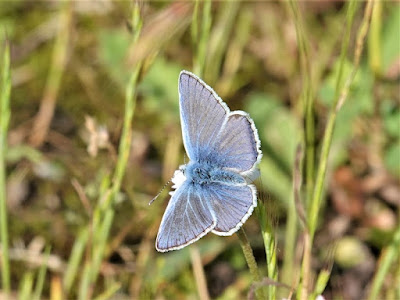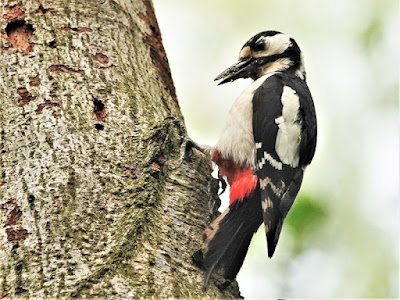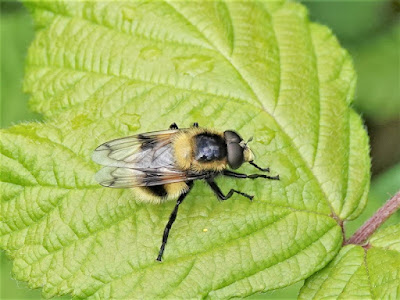11.0°C > 16.0°C: Good sunny intervals. Keen northerly breeze. Very good visibility.
Sunrise: 04:53 BST
* = a species photographed today
! = a new species for me here this year
!! = a new species for me in Shropshire
Priorslee Balancing Lake: 05:10 – 06:00 // 07:05 – 09:30
* = a species photographed today
! = a new species for me here this year
!! = a new species for me in Shropshire
Priorslee Balancing Lake: 05:10 – 06:00 // 07:05 – 09:30
(115th visit of the year)
New Bird Species
Highlight today was my first Hobby of the year that sped over the lake at 05:15, typically never to be glimpsed again. Bird species #92 here for me this year,
Bird notes:
- the resident Canada Geese have lost another gosling: now four.
- the Mute Swans seem to have lost one of their hitherto surviving cygnets. I only noted one though they were always a long way away from me. Meanwhile the cob had to chase off two visiting Mute Swans.
- there were seven adult Lesser Black-backed Gulls on the football field at 05:10. They flew off South. Another adult stopped off later.
Counts of birds noted flying over:
- 8 Greylag Geese: a quintet outbound; a trio inbound
- 2 Stock Doves together
- 15 Wood Pigeons
- 1 Hobby
- 1 Jackdaw
Hirundines etc. noted: see notes
- c.30 Swifts
- 2 Barn Swallows
- 4 House Martins
Warblers noted (the figure in brackets relates to birds heard singing):
- 1 (1) Cetti's Warbler
- 13 (11) Chiffchaffs
- 8 (8) Reed Warblers
- 14 (14) Blackcaps
'nominal' warbler:
- 2 (2) Goldcrests
Counts from the lake area:
- *2 + 4 (1 brood) Canada Geese
- *2 + 1 (1 brood) Greylag Geese
- 4 + 1 (1 brood) Mute Swans: two (near?) adults visited briefly: see notes
- 2 (2♂) Mallard
- 2 Moorhens
- 28 + 5 (3 broods) Coots
- 6 Great Crested Grebes
On the street lamps poles pre-dawn:
Nothing seen
Noted later:
Noted later:
Butterflies:
- Speckled Wood Pararge aegeria
- *Common Blue Polyommatus icarus
- Speckled Wood Pararge aegeria
- *Common Blue Polyommatus icarus
Moths:
- *!!White-line Pollen-moth Micropterix aruncella [White-barred Gold]: my moth species #26 here this year
- *!!White-line Pollen-moth Micropterix aruncella [White-barred Gold]: my moth species #26 here this year
Bees, wasps etc.:
- *unidentified mining bee Andrena sp.
- *Early Bumblebee Bombus pratorum
- Buff-tailed Bumblebee Bombus terrestris
- *Red Mason Bee Osmia bicornis
- *Common Wasp Paravespula vulgaris
- *unidentified mining bee Andrena sp.
- *Early Bumblebee Bombus pratorum
- Buff-tailed Bumblebee Bombus terrestris
- *Red Mason Bee Osmia bicornis
- *Common Wasp Paravespula vulgaris
Hoverflies:
- Buttercup Blacklet Cheilosia albitarsus [Late Buttercup Cheilosia]
- *!Bumblebee Blacklet Cheilosia illustrata
- Tapered Dronefly Eristalis pertinax
- *Migrant Field Syrph Eupeodes corollae [Migrant Hoverfly]
- Tiger Hoverfly Helophilus pendulus
- *Blotch-winged Hoverfly Leucozona lucorum [Blotch-winged Whitebelt]
- Chequered Hoverfly Melanostoma scalare [Long-winged Duskyface]
- *Bumblebee Plume-horned Hoverfly Volucella bombylans
- *!Pellucid Fly Volucella pellucens [Pied Plumehorn]
- Orange-belted Leafwalker Xylota segnis
- Buttercup Blacklet Cheilosia albitarsus [Late Buttercup Cheilosia]
- *!Bumblebee Blacklet Cheilosia illustrata
- Tapered Dronefly Eristalis pertinax
- *Migrant Field Syrph Eupeodes corollae [Migrant Hoverfly]
- Tiger Hoverfly Helophilus pendulus
- *Blotch-winged Hoverfly Leucozona lucorum [Blotch-winged Whitebelt]
- Chequered Hoverfly Melanostoma scalare [Long-winged Duskyface]
- *Bumblebee Plume-horned Hoverfly Volucella bombylans
- *!Pellucid Fly Volucella pellucens [Pied Plumehorn]
- Orange-belted Leafwalker Xylota segnis
Damsel-/dragon-flies:
- Common Blue Damselfly Enallagma cyathigerum
- *Red-eyed Damselfly Erythromma najas
- Blue-tailed Damselfly Ischnura elegans
- Common Blue Damselfly Enallagma cyathigerum
- *Red-eyed Damselfly Erythromma najas
- Blue-tailed Damselfly Ischnura elegans
Other flies:
- *long-legged fly Argyra sp.
- Black Snipefly Chrysopilus cristatus: males
- *!!Common Red-legged Robberfly Dioctria rufipes
- *dagger fly Hilara sp.
- Scorpion Fly Panorpa sp.
- Downlooker Snipefly Rhagio scolopaceus
- *Yellow Dung Fly Scathophaga stercoraria
many other unidentified species
- *long-legged fly Argyra sp.
- Black Snipefly Chrysopilus cristatus: males
- *!!Common Red-legged Robberfly Dioctria rufipes
- *dagger fly Hilara sp.
- Scorpion Fly Panorpa sp.
- Downlooker Snipefly Rhagio scolopaceus
- *Yellow Dung Fly Scathophaga stercoraria
many other unidentified species
Bugs etc.:
- *Mirid bug Calocoris alpestris
- Red-and-Black Froghopper Cercopis vulnerata
- Common Green Shieldbug Palomena prasina
- *!Red-legged Shieldbug Pentatoma rufipes: instar
- *Mirid bug Calocoris alpestris
- Red-and-Black Froghopper Cercopis vulnerata
- Common Green Shieldbug Palomena prasina
- *!Red-legged Shieldbug Pentatoma rufipes: instar
Beetles:
- Alder Leaf Beetle Agelastica alni
- *!!longhorn beetle Grammoptera ruficornis
- *Harlequin Ladybird Harmonia axyridis var. succinea
- False blister Beetle Oedemera lurida/virescens
- Swollen-thighed Beetle Oedemera nobilis
- *14 Spot Ladybird Propylea quattuordecimpunctata
- Alder Leaf Beetle Agelastica alni
- *!!longhorn beetle Grammoptera ruficornis
- *Harlequin Ladybird Harmonia axyridis var. succinea
- False blister Beetle Oedemera lurida/virescens
- Swollen-thighed Beetle Oedemera nobilis
- *14 Spot Ladybird Propylea quattuordecimpunctata
Molluscs:
- White-lipped Snail Cepaea hortensis
- Girdled Snail Hygromia cinctella
- White-lipped Snail Cepaea hortensis
- Girdled Snail Hygromia cinctella
Spiders:
- Long-jawed Orb-web Spider Tetragnatha sp.
- *unidentified spiderlings
- Long-jawed Orb-web Spider Tetragnatha sp.
- *unidentified spiderlings
New flower species noted:
- *Blue Flag Iris Iris versicolor
- *Hedge Woundwort Stachys sylvatica
- *Blue Flag Iris Iris versicolor
- *Hedge Woundwort Stachys sylvatica
Dawn!
The resident Canada Geese with their four remaining goslings.
And the Greylag Geese with their sole gosling.
Two Stock Doves, an adult in the front with the glossy neck patch. The juvenile behind lacks the neck patch and also lack the black on the folded wing.
As the adult turns its head the neck patch ceases to gloss.
Comparison_1: in the foreground a sharp Wood Pigeon with a rather fuzzy adult Stock Dove.
The upper-side of a male Common Blue Polyommatus icarus.
A new species of moth for me. It is a White-line Pollen-moth Micropterix aruncella.
I have not be able to identify this Andrena mining bee.
Can you bathe in a buttercup? This Early Bumblebee Bombus pratorum seems to think so.
A Red Mason Bee Osmia bicornis.
This Common Wasp Paravespula vulgaris looked larger than usual. Seems a bit late for a queen to still be around looking for a nest site.
Would you believe a Red-eyed Damselfly Erythromma najas?
My first Bumblebee Blacklet Cheilosia illustrata of the year. This is the only species in this genus that is not all-black and therefore about the only one I confidently identify.
A Migrant Field Syrph Eupeodes corollae.
"Reach for the sky". A Blotch-winged Hoverfly Leucozona lucorum.
Another Bumblebee Plume-horned Hoverfly Volucella bombylans
This species comes in two forms. This is the other, known bombylans form. The previous example is of the form plumata.
A closely-related species: this is a Pellucid Fly Volucella pellucens also known as Pied Plumehorn
I think this is a long-legged fly from Argyra species group.
My logs suggest this is my first-ever Common Red-legged Robberfly Dioctria rufipes.
One of the dagger flies Hilara sp.
Yet another buttercup-lover. The Mirid bug Calocoris alpestris.
An instar of a Red-legged Shieldbug Pentatoma rufipes.
Just about the smallest longhorn beetle it is Grammoptera ruficornis.
This is a larva of a Harlequin Ladybird Harmonia axyridis.
This species does not always show 14 'spots' but it is a 14 Spot Ladybird Propylea quattuordecimpunctata.
Spiderlings breaking out of their nest egg. I cannot identify the species,
A Blue Flag Iris Iris versicolor. This plant is not native to the UK and although it is found widely around lakes and ponds these all originate from garden escapes.
Just starting to flower is Hedge Woundwort Stachys sylvatica.
(Ed Wilson)
------------------------------------------------------------------------------------------------------
In the Priorslee Avenue tunnel:
Flies:
- 1 cranefly Epiphragma ocellare
and the usual midges of several species
The Flash: 06:05 – 07:00
- 1 cranefly Epiphragma ocellare
and the usual midges of several species
(Ed Wilson)
------------------------------------------------------------------------------------------------------
The Flash: 06:05 – 07:00
(117th visit of the year)
Bird notes:
- I could not find any Canada Goose goslings.
- now 12 (near) adult Mute Swans! Perhaps only two cygnets. I should have looked harder.
- there were four Great Crested Grebes loafing in close proximity at the top end. Some 15 minutes later I noted one at the bottom end when the top end was too far away to find those lurking among the geese and swans. A fifth? or a fast swimmer?
Bird(s) noted flying over here:
None
Hirundines etc. noted:
- 2 Swifts
- 1 House Martin
Warblers noted (the figure in brackets relates to birds heard singing):
- 4 (3) Chiffchaffs
- 2 (2) Blackcaps
'nominal' warbler:
- 2 (2) Goldcrests
Noted on / around the water:
- 62 Canada Geese
- 5 Greylag Geese
- 12 + 2 (1 brood) Mute Swans
- 16 (12♂) Mallard
- *2 (2♂) feral(?) Mallard
- 2 (1♂) Tufted Duck
- 5 + 2 (1 brood) Moorhens
- 19+ 5 (4 broods) Coots
- 4 or 5 Great Crested Grebes: see notes
Noted elsewhere around The Flash:
Hirundines etc. noted:
- 2 Swifts
- 1 House Martin
Warblers noted (the figure in brackets relates to birds heard singing):
- 4 (3) Chiffchaffs
- 2 (2) Blackcaps
'nominal' warbler:
- 2 (2) Goldcrests
Noted on / around the water:
- 62 Canada Geese
- 5 Greylag Geese
- 12 + 2 (1 brood) Mute Swans
- 16 (12♂) Mallard
- *2 (2♂) feral(?) Mallard
- 2 (1♂) Tufted Duck
- 5 + 2 (1 brood) Moorhens
- 19+ 5 (4 broods) Coots
- 4 or 5 Great Crested Grebes: see notes
Noted elsewhere around The Flash:
Bees:
- *Early Bumblebee Bombus pratorum
- *Early Bumblebee Bombus pratorum
Beetles:
- Alder Leaf Beetle Agelastica alni
- Alder Leaf Beetle Agelastica alni
One of two very similar-looking ducks I noted. It looks like a Mallard but is unusually pale. The all-dark bill suggests it is a drake. Drake Mallards do not look like this when they are going through their post-breeding moult. So where did they come from? [which reminds me: it is ages since I noted the long-staying all white feral Mallard...]











































































